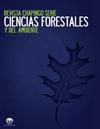墨西哥索诺拉红树林地上生物量碳储量的经济价值
IF 0.6
4区 农林科学
Q3 Agricultural and Biological Sciences
Revista Chapingo Serie Ciencias Forestales Y Del Ambiente
Pub Date : 2022-08-30
DOI:10.5154/r.rchscfa.2021.09.056
引用次数: 0
摘要
红树林提供环境产品和服务,减缓气候变化。目的:估算索诺拉州Bahía del Tóbari (BT)和El Sargento红树林地上生物量碳储量的经济价值。材料与方法:2014年和2015年在16个样地(10 × 10 m)进行野外研究。Gaertn、Rhizophora mangle L.和Avicennia germinans(L.)l由特定异速生长方程确定。碳储量和避免的二氧化碳当量排放量的换算系数分别为0.5和3.7;这些数据代表了2015年的基线。2020年的估计包括了红树林覆盖的变化。采用边际碳减排成本法确定经济价值。结果和讨论:2015年基线显示BT的储量为52.1 MgC∙ha-1和191.2 tCO2e∙ha-1, El Sargento的储量为71.7 MgC∙ha-1和263.2 tCO2e∙ha-1。到2020年,BT和El Sargento的预估排放量分别为69 368.2 tCO2e∙TA-1(TA = 362.79 ha)和116 696tCO2e∙TA-1(TA = 468.32 ha)。这些排放的经济价值为BT的131 799.5美元(世界银行)和180 357.2美元(自愿碳市场),El Sargento的221 722.2美元(世界银行)和303 409.4美元(自愿碳市场)。结论:El Sargento记录了最高的C储量和经济价值。与该地区的其他研究相比,这两个地点都避免了更高的二氧化碳排放量。本文章由计算机程序翻译,如有差异,请以英文原文为准。
Economic value of aboveground mangrove biomass carbon storage in Sonora, Mexico
Introduction: Mangroves provide environmental goods and services that mitigate climate change. Objective: To estimate the economic value of the carbon stock in the aboveground biomass of mangroves in Bahía del Tóbari (BT) and El Sargento in Sonora. Materials and methods: Field research were conducted in 2014 and 2015 in 16 plots (10 x 10 m). Biomass of Laguncularia racemosa (L.) Gaertn, Rhizophora mangle L. and Avicennia germinans(L.) L. was determined with specific allometric equations. Carbon stocks and avoided CO2e emissions were estimated with conversion factors 0.5 and 3.7, respectively; these data represented the 2015 baseline. The 2020 estimates included changes in mangrove cover. The economic value was determined using the marginal carbon abatement cost method. Results and discussion: The 2015 baseline indicated reserves of 52.1 MgC∙ha-1 and 191.2 tCO2e∙ha-1 for BT, and 71.7 MgC∙ha-1 and 263.2 tCO2e∙ha-1 for El Sargento. By 2020 avoided emissions of 69 368.2 tCO2e∙TA-1 (TA= 362.79 ha) were estimated for BT and 116 696tCO2e∙TA-1(TA = 468.32 ha) for El Sargento. Economic values of these emissions were 131 799.5 USD (World Bank) and 180 357.2 USD (voluntary carbon market) for BT and 221 722.2 USD (World Bank) and 303 409.4 USD (voluntary carbon market) for El Sargento. Conclusions: The highest estimates of C reserves and economic value were recorded at El Sargento. Compared to other studies in the region, both sites had higher avoided CO2e emissions.
求助全文
通过发布文献求助,成功后即可免费获取论文全文。
去求助
来源期刊
CiteScore
1.20
自引率
16.70%
发文量
0
审稿时长
>12 weeks
期刊介绍:
The Revista Chapingo Serie Ciencias Forestales y del Ambiente (RCHSCFA) is a scientific journal that aims to raise awareness of high-quality research products related to forest, arid, temperate and tropical environments in the world. Since its foundation in 1994, the RCHSCFA has served as a space for scientific dissemination and discussion at a national and international level among academics, researchers, undergraduate and graduate students, forest managers and public/private entities that are interested in the forest environment.
All content published in the journal first goes through a strict triple-blind review process and is published in the following formats: Scientific Articles, Review Articles, Methodologies, Technical or Technological Notes.

 求助内容:
求助内容: 应助结果提醒方式:
应助结果提醒方式:


